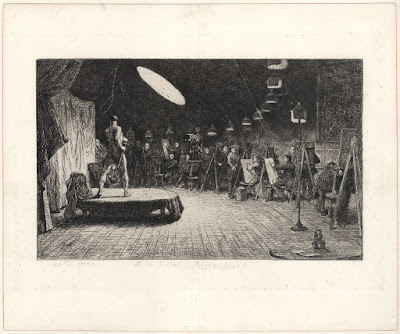Charles
West Cope (1811–1890)
“Life School Royal Academy”, 1865, published in 1868 by Philip Gilbert Hamerton (1834–1894) in “Etching
and Etchers” (London).
Etching and drypoint on laid paper with (flattened) centrefold and
full margins (as published) backed with a support sheet.
Size: (sheet) 25.3 x 30.6 cm; (plate) 19.9 x 28.7 cm; (image
borderline) 15.6 x 25.2 cm
Inscribed on plate below the image borderline: (left) "CWC
1865"; (centre) "Life School Royal Acady"
The British Museum offers the following description of this print:
“… interior of the life school of the Royal Academy: artists in a
curved line, under lamps, drawing at easels, from a model on a low round dias
under a large lamp, with a drape and curtain on the left, standing with one leg
in front of the other and drawing a sword.”
See also the description of this print at the Royal Academy:
National Gallery of Victoria (Melbourne):
FAMSF (Fine Art Museums of San Francisco):
Condition: faultless impression in excellent condition (i.e. there
are no tears, holes, folds, abrasions, stains or foxing) with only minimal
signs of handling in terms of minor surface marks. The sheet is backed with archival (millennium quality) washi paper (to flatten the published centrefold which is now virtually
invisible),
I am selling this historically important etching—one of the most
famous images of a 19th century life class—for the total cost of AU$323
(currently US$244.11/EUR204.44/GBP179.77) including postage and handling to
anywhere in the world.
If you are interested in purchasing this superb impression that has been professionally flattened to minimise the crease of the centrefold
when the print was published, please contact me
(oz_jim@printsandprinciples.com) and I will send you a PayPal invoice to make
the payment easy.
This etching of a 19th century life class (i.e. a
drawing class featuring a nude figure as a model) at the Royal Academy is one
of the most famous images of such a class. Its fame is partly because the
portrayed scene is a strong and memorable composition with the curved
arrangement of easels and overhead lights illuminating the nude model. Beyond the
visually arresting theatricality of the scene, however, the image is also a
rare and valuable historical document of how life classes were organised—and hopefully
are still run.
From my own experience of setting up such classes, I thought I
might offer a few insights about the organisation of classes like this …
A key principle in organising a large group of students in a life
class is to propose that the group should arrange their easel and viewpoint
according to whether they are left or right-handed. Usually right-handed
students will find that the easel is best placed/angled so that they are facing
the easel in a clockwise direction to the model, whereas a left-handed students
will face the model in the reverse direction. Such an arrangement will allow
for the students’ measuring arms to be closest to the model.
An issue that I see as a problem in this class is that some students have not angled
their board that they are drawing upon so that it “faces” them squarely at 90
degrees to the angle of their head. This is especially important for students
sitting at what are termed “donkeys” (i.e. a long stool that a student will sit
astride and which has a support at one end to “hold” the drawing board). Again
this is an important consideration, as parallax error will result when measuring and recording proportions if the drawing surface is not "square" with the student's angle of view.
Now that I am thinking about the problems associated with working
on drawing donkeys I need to point out a very practical consideration: charcoal
dust will fall from the drawing onto one’s legs when seated at a donkey unless
a rag is placed strategically to catch the dust. From looking at this class I
envisage the distress of going out for dinner following such a class with a
stripe of black soot across one’s legs because no preventative measures were in
place.








No comments:
Post a Comment
Please let me know your thoughts, advice about inaccuracies (including typos) and additional information that you would like to add to any post.